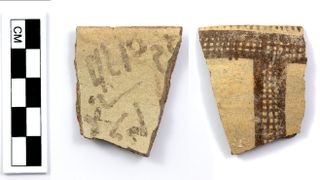Alphabet's 'missing link' possibly discovered

An alphabetic inscription written on a jar fragment found at the site of Tel Lachish in Israel and dating back around 3,450 years may provide a "missing link" in the history of the alphabet, a team of researchers said.
"Dating to the fifteenth century B.C., this inscription is currently the oldest securely dated alphabetic inscription from the Southern Levant," wrote the researchers led by Felix Höflmayer, an archaeologist at the Austrian Archaeological Institute, in a paper published April 14 in the journal Antiquity.
The earliest evidence of writing that uses a system of letters to represent sounds — an alphabet — was found in Egypt and dates to the 12th dynasty (around 1981 B.C. to 1802 B.C.), with more examples being found from around 1300 B.C. in the Levant (an area that includes modern-day Israel), Höflmayer's team wrote in their paper. In later times, the Greeks adopted the use of an alphabet system, followed by the Romans (with their Latin writing system) who also used one. The use of an alphabet system was gradually adopted by more and more cultures.
Related: Cracking codices: 10 of the most mysterious ancient manuscripts
The recently discovered inscription, dating to around 1450 B.C., is being called a "missing link," because it fills a gap between early examples of alphabetic writing from Egypt and later examples found in the Levant, wrote Höflmayer's team. The inscription also provides clues about how the alphabet may have been transmitted to the Levant, with the team suggesting that the Hyksos, a group from the Levant that ruled northern Egypt until around 1550 B.C., may have helped to bring the alphabet from Egypt to the Levant. Their reasoning is based on the fact that, for a time, the Hyksos controlled territory in both the Levant and northern Egypt. It is also based on the fact that hieroglyphic symbols were used to symbolize letters on this jar.
Short inscription
The newly found alphabetic inscription is quite short: The first word in the inscription contains the letters ayin, bet and dalet, while the second word contains the letters nun, pe and tav. All of these letters are part of the early Semitic alphabet used at one time on the Arabian Peninsula; they can also be found today in the Hebrew language, although the modern-day symbols look different.
The writer used hieroglyphic symbols to represent some of the letters; for instance, ayin was represented with a hieroglyphic symbol that looks like an eye.
Sign up for the Live Science daily newsletter now
Get the world’s most fascinating discoveries delivered straight to your inbox.
"As in most early alphabetic inscriptions from the Southern Levant, the letter is shaped like a circle, resembling an iris with the pupil missing," the team wrote in the Antiquity article.
They aren't sure what the words mean, though they may be part of two names, the team said. The inscription is being called a missing link because it dates to around 3,450 years ago, after the first alphabetic symbols appeared in Egypt around 3,900 years ago but before they appeared again in the Levant around 3,300 years ago.
The letters in the first word can spell out "slave," though this doesn't mean that the inscription refers to an enslaved person. The researchers noted that the surviving letters are likely part of longer words, and the combination of those letters that spell out "slave" are used in many other words.
The inscription was uncovered by archaeologists in 2018 near an ancient fortification at Tel Lachish. The researchers also found the remains of barley alongside the jar fragment holding the inscription, and radiocarbon dating indicated that the barley was grown in around 1450 B.C.
That date may be controversial, however, said Benjamin Sass, an archaeology professor at Tel Aviv University who has written extensively about the early history of the alphabet, but who was not involved in the study. The dating of the barley may or may not be an accurate date for the inscription, Sass noted. (For instance, the barley could have been harvested after the jar.) "The data published so far makes this a possibility, but by no means a certainty," Sass told Live Science.
Originally published on Live Science.

Owen Jarus is a regular contributor to Live Science who writes about archaeology and humans' past. He has also written for The Independent (UK), The Canadian Press (CP) and The Associated Press (AP), among others. Owen has a bachelor of arts degree from the University of Toronto and a journalism degree from Ryerson University.
